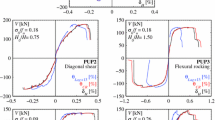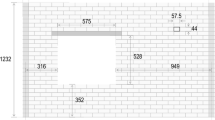Abstract
This article introduces an analytical model to compute the monotonic force–displacement response of in-plane loaded unreinforced brick masonry walls accounting for walls failing in shear or flexure. The masonry wall is modelled as elastic in compression with zero tensile strength using a Timoshenko beam element. Its cross-section properties (moment of inertia and area) are continuously updated to capture the non-linearity that results from flexural and shear cracking. For this purpose, diagonal cracking of shear critical walls is represented by one Critical Diagonal Crack. The ultimate drift capacity of the wall is determined based on an approach evaluating a plastic zone at the wall toe. Validation against results of cyclic full-scale tests of unreinforced masonry walls made with vertically perforated clay units shows that the presented formulation is capable of accurately predicting the effective stiffness, the maximum strength and the ultimate drift capacity of the wall. It outperforms current empirical code equations with regard to stiffness and ultimate drift capacity estimates and yields similar results concerning strength prediction.



























Similar content being viewed by others
Abbreviations
- M :
-
Global bending moment (Nm)
- M e :
-
Bending moment at which decompression in overall cross section occurs (Nm)
- M e,i :
-
Bending moment at which decompression in cross section part i (for i ∈ {1, 2}) occurs (Nm)
- M i :
-
Bending moment in cross section part i (for i ϵ {1, 2}) (Nm)
- N :
-
Global normal force (N)
- N i :
-
Normal force in cross section part i (for i ϵ {1, 2}) (N)
- N 1,2,3 :
-
Normal forces for calculation of residual strength (N)
- V :
-
Global shear force (N)
- V cr :
-
Shear force at which diagonal crack formation starts (N)
- V CP :
-
Shear force triggering failure in flexural walls (N)
- V P :
-
Peak shear resistance (N)
- V R :
-
Residual strength (N)
- V 1,2,3 :
-
Shear forces for calculation of residual strength (N)
- σ 0 :
-
Normal force divided by full cross sectional area of the wall (N/m²)
- σ M :
-
Normal stresses due to global moment (N/m²)
- σ N :
-
Normal stresses due to normal force (N/m²)
- σ T :
-
Normal stresses due to torque moment (N/m²)
- σ xx :
-
Normal stresses in a cross section (N/m²)
- τ xy :
-
Shear stresses in a cross section (N/m²)
- u :
-
Horizontal displacement (m)
- u fl :
-
Horizontal displacements due to flexure (m)
- u sh :
-
Horizontal displacements due to shear (m)
- w :
-
Axial displacement (m)
- δ :
-
Horizontal drift (−)
- δ P :
-
Horizontal drift at peak shear resistance (−)
- δ ult :
-
Ultimate drift (−)
- θ :
-
Rotation (rad)
- θ ult :
-
Rotation at ultimate drift (rad)
- ɛ u :
-
Normal strain masonry is able to sustain at the wall toe (−)
- ɛ xx :
-
Normal strains in cross section (−)
- ɛ 2 :
-
Normal strain in crushed zone dependent on axial loading (−)
- χ :
-
Curvature of a cross section (m−1)
- χ cr :
-
Curvature on bottom crushed zone in shear walls (m−1)
- χ 1,2 :
-
Curvature at ultimate failure in 1st and 2nd bed joint respectively in flexure dominated walls (m−1)
- E :
-
Modulus of elasticity (N/m²)
- G :
-
Shear modulus (N/m²)
- f B,c :
-
Compressive strength of brick (N/m²)
- f B,t :
-
Tensile strength of brick (N/m²)
- f u :
-
Compressive strength of masonry (N/m²)
- μ :
-
Local coefficient of friction (−)
- μ :
-
Global coefficient of friction (−)
- c :
-
Local cohesion (N/m²)
- c :
-
Global cohesion (N/m²)
- A :
-
Cross sectional area of overall cross section (m²)
- H :
-
Height of wall (m)
- H 0 :
-
Shear span of wall (m)
- H crit :
-
Height where the diagonal crack is presumed to commence (m)
- H M :
-
Height where normal stresses due to moment at diagonal crack turn negative (tensile stresses) (m)
- h B :
-
Height of brick (m)
- h cr :
-
Height of crushed zone at wall toe (m)
- h d :
-
Height along which decompression occurs (m)
- I :
-
Moment of inertia of overall cross section (m4)
- I eig,i :
-
Moment of inertia corresponding to centre of gravity of cross section part i (for i ϵ {1, 2}) (m4)
- I eig :
-
Sum of moments of inertia corresponding to respective centres of gravities of parts of cross section (m4)
- I st :
-
Sum of moments of inertia corresponding to parallel axis theorem of parts of cross section (m4)
- L :
-
Length of wall (m)
- L c :
-
Compressed length of overall cross section (m)
- L c,i :
-
Compressed length of cross section part i (for i ϵ {1, 2}) (m)
- L c,v :
-
Virtual compressed length (m)
- L i :
-
Length of wall part i (for i ϵ {1, 2}) (m)
- L i,v :
-
Auxiliary length for computation of shear stress distribution in section part i (for i ϵ {1, 2}) (m)
- L P :
-
Length of plastic normal stress distribution at toe crushing (m)
- l B :
-
Length of brick (m)
- l cr :
-
Length of crushed zone at wall toe (m)
- l cor,i :
-
Length of corner i (for i ϵ {1, 2}) (m)
- T :
-
Thickness of wall (m)
- y CDC :
-
Horizontal distance from wall edge to CDC (m)
- x :
-
Location variable along wall height (m)
- y :
-
Location variable along wall length (m)
- y * :
-
Auxiliary location variable along wall length (m)
- Δl :
-
Discrete step along wall height (m)
- γ :
-
Deformation constraint factor (−)
References
ASCE (2000) FEMA 356—Prestandard and commentary for the seismic rehabilitation of buildings. American Society of Civil Engineers, Reston
Atkinson RH, Amadei BP, Saeb S, Sture S (1990) Response of masonry bed joints in direct shear. J Struct Eng 115:2276–2296
Belmouden Y, Lestuzzi P (2009) An equivalent frame model for seismic analysis of masonry and reinforced concrete buildings. Constr Build Mater 23:40–53. doi:10.1016/j.conbuildmat.2007.10.023
Benedetti A, Steli E (2008) Analytical models for shear–displacement curves of unreinforced and FRP reinforced masonry panels. Constr Build Mater 22:175–185. doi:10.1016/j.conbuildmat.2006.09.005
Bosiljkov V, Tomazevic M, Lutman M (2004) Optimization of shape of masonry units and technology of construction for earthquake resistant masonry buildings—part one and two. Lubljana, Slowenia
Bosiljkov V, Tomazevic M, Lutman M (2006) Optimization of shape of masonry units and technology of construction for earthquake resistant masonry buildings—part three. Lubljana, Slovenia
Caliò I, Marletta M, Pantò B (2012) A new discrete element model for the evaluation of the seismic behaviour of unreinforced masonry buildings. Eng Struct 40:327–338. doi:10.1016/j.engstruct.2012.02.039
CEN (2004) EN 1998-1: 2004 Eurocode 8: design of structures for earthquake resistance—part 1: general rules, seismic actions and rules for buildings. Comité Européen de Normalisation
CEN (2005a) EN 1998-3: 2005 Eurocode 8: design of structures for earthquake resistance—part 3: assessment and retrofitting of buildings. Comité Européen de Normalisation
CEN (2005b) EN 1996-1-1:2005 Eurocode 6: design of masonry structures—part 1-1: general rules for reinforced and unreinforced masonry structures. Comité Européen de Normalisation
Chen S-Y, Moon FL, Yi T (2008) A macroelement for the nonlinear analysis of in-plane unreinforced masonry piers. Eng Struct 30:2242–2252. doi:10.1016/j.engstruct.2007.12.001
Elsche B (2008) Zur rechnerischen Modellierung der Beanspruchungen und der Tragfähigkeit von aussteifenden Mauerwerkswänden. Phd Thesis, Technische Universität Dortmund
Frumento S, Magenes G, Morandi P, Calvi GM (2009) Interpretation of experimental shear tests on clay brick masonry walls and evaluation of q-factors for seismic design. Technical report, IUSS Press, Instituto Universitario di Studi Superiori di Pavia, Italy
Ganz H (1985) Mauerwerksscheiben unter Normalkraft und Schub. PhD thesis, Eidgenössische Technische Hochschule Zürich, Switzerland
Ganz H, Thürlimann B (1984) Versuche an Mauerwerksscheiben unter Normalkraft und Querkraft. Test Report. ETH Zürich, Zürich
Lang K (2002) Seismic vulnerability of existing buildings. PhD-Thesis, ETH Zürich
Lourenço PB (1996) Computational strategies for masonry structures. PhD-Thesis, TU Delft
Magenes G, Calvi GM (1997) In-Plane seismic response of brick masonry walls. Earthq Eng Struct Dyn 26:1091–1112
Mann W, Müller H (1982) Failure of shear-stressed masonry. An enlarged theory, tests and application to shear walls. Proc Br Ceram Soc 30:223–235
Möhler K (1956) Über das Tragverhalten von Biegeträgern und Druckstäben mit zusammengesetztem Querschnitt und nachgiebigen Verbindungsmitteln. Technische Hochschule Karlsruhe
NTC (2008) Decreto Ministeriale 14/1/2008: Norme tecniche per le costruzioni. Ministry of Infrastructures and Transportations
NZSEE (2011) Assessment and Improvement of Unreinforced Masonry Buildings for Earthquake Resistance, New Zealand Society of Earthquake Engineering, supplement to “Assessment and improvement of the structural performance of buildings in earthquakes.” University of Auckland
Penna A, Lagomarsino S, Galasco A (2014) A nonlinear macroelement model for the seismic analysis of masonry buildings. Earthq Eng Struct Dyn 43:159–179. doi:10.1002/eqe.2335
Petry S, Beyer K (2014) Influence of boundary conditions and size effect on the drift capacity of URM walls. Eng Struct 65:76–88. doi:10.1016/j.engstruct.2014.01.048
Petry S, Beyer K (2015a) Cyclic test data of six unreinforced masonry walls with different boundary conditions. Earthq Spectra 31:2459–2484. doi:10.1193/101513EQS269
Petry S, Beyer K (2015b) Force-displacement response of in-plane-loaded URM walls with a dominating flexural mode. Earthq Eng Struct Dyn 44:2551–2573. doi:10.1002/eqe.2597
Raka E, Spacone E, Sepe V, Camata G (2015) Advanced frame element for seismic analysis of masonry structures: model formulation and validation. Earthq Eng Struct Dyn 44:2489–2506. doi:10.1002/eqe.2594
Salmanpour AH, Mojsilović N, Schwartz J (2015) Displacement capacity of contemporary unreinforced masonry walls: an experimental study. Eng Struct 89:1–16. doi:10.1016/j.engstruct.2015.01.052
Schneider KH, Jucht K-D, Wiegand E (1976) Innerer Spannungszustand bei Mauerwerk mit nicht vermörtelten Stoßfugen. Kurzbericht über ein vom Bundesministerium für Raumordnung, Bauwesen und Städtebau gefördertes Forschungsvorhaben, Frankfurt/Main
SIA (2011) SIA D0237: Evaluation de la sécurité parasismique des bâtiments en maçonnerie. Swiss Society of Engineers and Architects SIA, Zürich
Turnsek V, Cacovic F (1971) Some experimental results on the Strength of Brick Masonry Walls
Zhang S, Petry S, Beyer K (2014) Investigating the in-Plane Mechanical Behavior of Urm Piers Via DSFM
Acknowledgements
This study has been supported by the Grant No. 159882 of the Swiss National Science Foundation: “A drift capacity model for unreinforced masonry walls failing in shear”. The authors also gratefully acknowledge the contribution by two anonymous reviewers who provided helpful comments.
Author information
Authors and Affiliations
Corresponding author
Appendices
Appendix 1: Wall tests used for the validation
The walls and their parameters used in the validation of the model are presented in Tables 2 and 3. The shear modulus G is always taken as ¼ of the elastic modulus E, the tensile strength of a brick (f B,t ) was assumed to be 1.27 MPa for all walls corresponding to the testing campaign by Petry and Beyer (2015a) as values in other reference documents were not provided.
Appendix 2: Comparison of CDC model to wall tests
Rights and permissions
About this article
Cite this article
Wilding, B.V., Beyer, K. Force–displacement response of in-plane loaded unreinforced brick masonry walls: the Critical Diagonal Crack model. Bull Earthquake Eng 15, 2201–2244 (2017). https://doi.org/10.1007/s10518-016-0049-7
Received:
Accepted:
Published:
Issue Date:
DOI: https://doi.org/10.1007/s10518-016-0049-7







